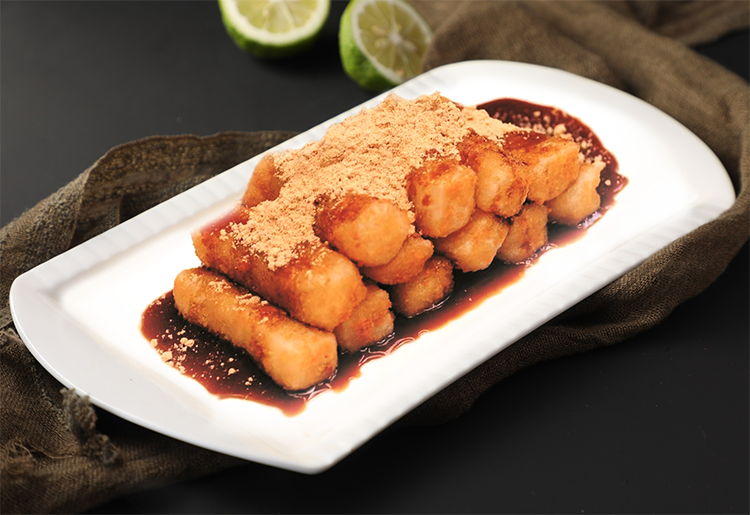Hunan Ciba: Sticky Rice Cake of Reunion
1. Hunan’s Soul Food Ciba: Soft, Chewy, Full of Warmth
“Soft, sweet, endlessly adaptable—every bite carries Hunan’s homey warmth and history.”
In an old Hunan town, the rhythmic “hi-yo” calls and the dull thud of wooden mallets on a stone mortar announce a timeless ritual. The sweet aroma of steamed glutinous rice fills the air as families take turns pounding the hot rice into a smooth, elastic mass.
Ciba (糍粑), the Hunan sticky rice cake, is more than a snack—it’s a living tradition, embodying community, memory, and celebration.
2. Centuries of Tradition: Ciba as Hunan’s Culinary Chronicle
Ciba’s roots trace back to southern China’s rice-cultivating culture. In Hunan, fertile lands have produced glutinous rice for generations. Farmers originally made ciba as a practical way to preserve their harvest: steamed sticky rice pounded into cakes that could be stored and carried.
Over time, ciba became a ceremonial staple. Families still gather before Lunar New Year to pound ciba together, symbolizing unity and wishes for a sweet, abundant year. It’s also a customary gift at weddings, birthdays, and housewarmings—each cake carrying blessings of luck and prosperity.

3. The Handmade Technique: Heat, Water, and the Rhythm of Pounding
A great ciba begins with high-quality glutinous rice. Hunan’s round sticky rice is prized for its softness and elasticity. The rice is soaked, drained, then steamed until fully cooked.
The craft lies in the pounding. Hot rice is placed in a stone mortar; one person wets and flips the rice while another pounds with a heavy wooden mallet. Timing, strength, and coordination are key. Repeated strikes transform the rice into a uniform, airy, elastic dough—the hallmark of hand-pounded ciba.
After pounding, the rice mass is shaped into logs, divided, and pressed into rounds or bars. Properly made ciba retains a soft, springy interior and can be stored as a dry cake or eaten fresh.
4. Endless Ways to Enjoy: Sweet, Savory, Fried, or Boiled
Ciba is incredibly versatile in Hunan cuisine:
- Classic sweet: Pan-fried until golden, then dusted with white sugar or roasted soybean powder.
- Brown sugar soup: Simmered in brown sugar and ginger syrup for a warm, slightly spicy treat.
- Savory stir-fry: Fried with cured bacon (Hunan laba or lap yuk) to absorb smoky, salty fat.
- Charcoal-grilled: Skewered and roasted over coals until the outside blisters, releasing a smoky rice aroma.
Each preparation highlights different textures and flavors, showcasing Hunan’s culinary creativity.

5. Texture and Flavor: The Chewy, Airy Pleasure
Fresh hand-pounded ciba has a springy, elastic chewiness and a fragrant, slightly sweet aroma. When fried, the exterior can crisp, while the inside stretches in delicate threads. The airy texture, resulting from pounding, sets ciba apart from compact rice cakes.
This neutral yet fragrant base pairs beautifully with sugar crystals, soybean powder, or the savory richness of cured meats.
6. Where and When to Taste Ciba in Hunan
- Best season: Autumn and winter, especially around Lunar New Year when village pounding events are common.
- Where to go: Pozi Street and Huogongdian area in Changsha, or stone lanes in Fenghuang Ancient Town, Xiangxi. Street vendors who pound or fry ciba on-site offer the most authentic experience.
- What to try first: Classic sugar-and-soybean powder or warm brown-sugar syrup. For savory lovers, stir-fried ciba with cured bacon is recommended.
- Buying to take home: Many Hunan specialty shops sell vacuum-packed dry ciba. Choose well-labeled packages and check production dates.

7. Make a Simple Home Version: Quick Hunan Ciba
You can enjoy Hunan-style ciba at home using glutinous rice flour.
Ingredients: glutinous rice flour, warm water, brown sugar, fresh ginger, a little oil.
Steps:
- Mix glutinous rice flour with warm water to form a smooth, pliable dough.
- Roll into a log, cut into small pieces, and flatten each into a round.
- Pan-fry over low heat with a thin layer of oil until golden and puffed.
- In a separate pot, simmer water with brown sugar and ginger slices to make syrup.
- Add fried ciba to the syrup briefly to absorb sweetness. Serve warm.
This quick version won’t fully replicate the airy texture of hand-pounded ciba, but it captures the comforting flavors of Hunan’s beloved sticky rice cake.
8. Conclusion: A Taste of Hunan Tradition
A steaming bowl of brown-sugar ciba in winter or a sizzling plate with cured bacon exemplifies Hunan’s hearty spirit. More than a snack, ciba is a cultural emblem celebrating family, fellowship, and life’s simple pleasures. When visiting Hunan, tasting freshly made ciba is a must—let its soft, fragrant aroma become one of your enduring travel memories.



